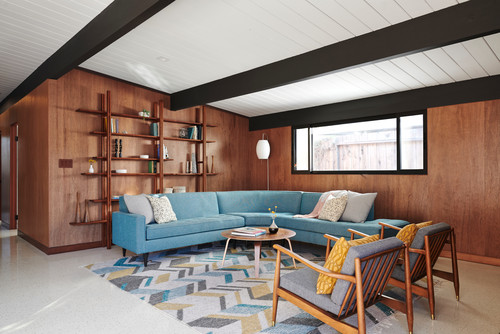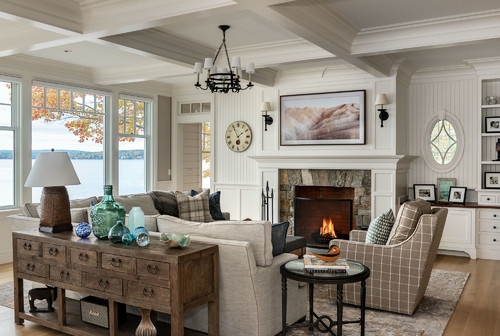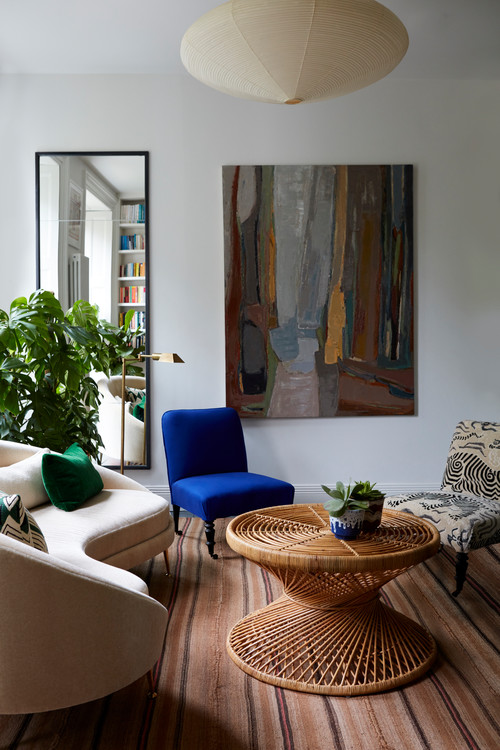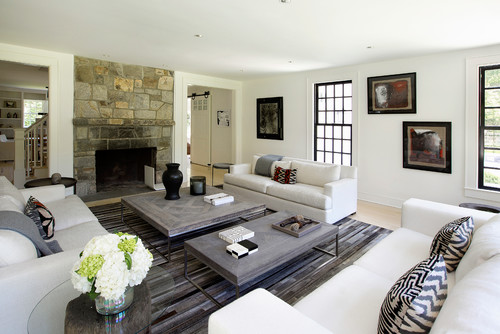Key measurements for your living room
February 21st, 2019
Learn the basic dimensions that will allow good circulation, flow and balance as you fit in all the furnishings you want.
Whether you are laying out a living room for your first apartment or planning one for your new custom home, understanding the scale of furniture and its relationship to the room can help you create a comfortable and functional space. The first thing to keep in mind is that you want the proportions of the furniture to coordinate with the proportions of the room. The following layout suggestions and common furniture sizes will help you get the living room design you want.
Single Sofa
Sofas are used frequently in most households. Buy a good-quality one so that it holds up, feels comfortable and maintains its looks.
On average sofas are about 84 inches (213 centimeters) long and 38 in. (98 cm) deep. A 72-in. (183-cm) sofa could work well in a smaller living room, while one that is 96 in. (244-cm) long could fit in a larger space.
Sectional Sofa
Essentially made up of two sofas placed perpendicular to each other, sectional sofas add plenty of seating. As with sofas, sectionals come in various sizes. Two 84-in. (213-cm) sectional pieces together need a space that is 7 feet (213 cm) wide and 10 feet (305 cm) long, which is usually a significant portion of a room.
Shaped Sofa
Sofas like this one, and other shaped sofas, usually take up more space than average. This example is about 11 feet (335 cm) long and needs a total depth of about 54 in. (137 cm).
Televisions
Since televisions now come in a wide variety of sizes, arranging furniture for them depends on which TV is chosen and how it’s used.
Depending on your TV type and screen size, you will want to keep your seating within 1.5 to 2.5 times the diagonal length of TV screen.
Also, carefully consider the TV height. Having the middle of the screen at eye level for a seated adult is optimum (about 42 in. or 107 cm). Mounting it above a fireplace may raise that height. In cases like that, the screen may be 48 to 60 in. (122 to 152 cm) above the floor, and you may be looking upward from your seating area to view it.
Love Seat
When you need a couple of extra seats or you just don’t have room for a sofa, consider a love seat. Love seats are usually around 5 feet (152 cm) long. The depth varies depending on the style, but plan on 38 to 40 in. (97 to 102 cm) at least. You can pair one with a sofa, as seen here, or set it alone.
Lounge Chairs
Lounge chairs usually swivel, rock and lean back, so they need extra space. When you combine it with an ottoman, you will want to allow for the ottoman’s footprint as well as room for someone to walk around both pieces comfortably.
Lounge chair sizes vary considerably, but plan to allow at least 66 in. (168 cm) from the back of the chair to the front of the ottoman and 36 to 40 in. (91 to 102 cm) of width.
Accent Chairs
For upholstered accent chairs allow about 36 to 40 in. (91 to 102 cm) of width and 40 to 44 in. (102 to 112 cm) of depth. One could easily move around the classic bent-plywood Eames chairs seen here, which are trim at 22 in. (56 cm) wide and 24 in. (61 cm) deep.
Stools and Benches
When you want a decorative touch or when you will occasionally need an extra seat or ottoman, consider placing stools and benches in your layout. Stools may be 16 to 20 in. (41 to 51 cm) square; benches are around 14 to 18 in. (36 to 46 cm) deep and 36 to 60 in. (91 to 152 cm) long.
Sofa Tables
Larger spaces can accommodate a sofa table, or console table, as in this living room. Most sofa tables are 14 to 20 in. (36 to 51 cm) deep and 60 to 72 in. (152 to 183 cm) long. These are great for placing lamps upon and for giving balance to sofas that float in a room. Keep in mind that you will need to conceal electrical cords under rugs or have floor outlets for the lamps.
End Tables
Square and rectangular tables commonly range from 20 to 30 in. (51 to 76 cm) in either direction. If they are to hold table lamps, be certain that they are large enough for the scale of lamp that you choose and that they allow other items to be set around them (for example, coasters for drinking glasses).
Cocktail and Coffee Tables
Cocktail and coffee tables often are focal points, since they belong in the center of a room. Not only will you want them to look good, but you will also want them to function well. Round and oval-shaped ones can be easier to move around, but squares and rectangles will give you more surface area.
You can place them as close as 12 in. (30 cm) from your seating. Keep them less than 18 to 20 in. (46 to 51 cm) from the chairs and sofas so that you can easily reach items you set down. Allow at least 42 in. (107 cm) in length or radius for modest-size tables and as much as 66 to 72 in. (168 to 183 cm) for larger-scale furnishings.
Floor Lamps
Don’t forget about floor lamps. One or two of them will illuminate a room evenly. They also come in a great variety of sizes, and you will want to find one that coordinates with the finishes of your room and that complements the scale of your design.
Floor lamps take up relatively little floor space. Plan for a space that’s at least 10 to 12 in. (25 to 31 cm) in diameter and 54 to 84 in. (137 to 213 cm) in height.
Artwork
Before committing to all of the furnishings that you wish to place in your living room, think about your artwork. Large paintings need generous wall space and ideally should be displayed farther from the entry points so that they can be seen by someone entering a room. A good tip is to hang them low enough so that the top is just above eye level, with the midpoint at around 57 to 60 in. (145 to 152 cm) off the floor.
Sculptures as well need their own space and should be placed so that they can be viewed enjoyably. Allow floor space in proportion to the size of the sculpture. Pedestals should not be more than 16 in. (41 cm) in diameter, or should be square and have dimensions relative to the scale of the sculpture.
Pianos
While not every living room is going to have a piano, it can make for a beautiful — and musical — addition.
The smallest grand pianos are about 60 in. (152 cm) wide and 60 in. (60 cm) long. Larger ones are around 72 in. (183 cm) long. Allow for a bench that is about 20 in. (51 cm) wide and 42 in. (107 cm) long as well. Based on these dimensions, it is wise to allow a clear floor space that’s at least 7 feet (213 cm) wide and 10 feet (305 cm) long to accommodate a grand piano.
Living Room Layout Ideas
This illustration shows several pieces of furniture commonly found in a living room. Your requirements will vary, but the principles are the same.
You want the room to flow around the furniture for circulation and also have clear paths to the seating areas and exit points. Circulation paths need 30 to 36 in. (77 to 91 cm) of clear width.
You can place coffee or cocktail tables as close as 12 in. (30 cm) from the edge of the seating. Other furnishings might need at least 24 in. (61 cm) between pieces for people to easily move about.
Another important consideration is the conversation arc. Place furniture so that people can easily hear one another when seated. Eight feet (244 cm) is ideal; larger rooms may need to be broken into seating groups.
When space and budget allow, several sofas can be arranged around oversize cocktail tables, as has been done in this transitional space. Notice that the square table is centered between the two sofas opposite each other, while the narrow table serves the sofa opposite the stone fireplace.
Though this space breaks out of the 8-foot conversation arc, each sofa is its own seating group. The lower ceiling maintains intimacy, and a generous circulation space around the room keeps each sofa’s seating area sufficiently private. A room needs to be at least 20 feet (610 cm) square for an arrangement like this.
Original source: Houzz
Read original article here.
Original article: The Province
Read original aricle here.
















